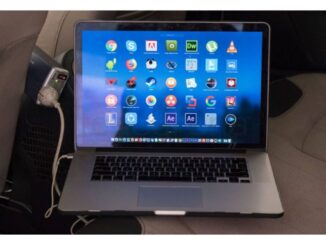
Have you ever wondered about what is the full form of LAPTOP?
If yes, then here is the answer. The full form of LAPTOP is “Lightweight Analytical Platform with Total Optimized Power.”
Laptop computers are increasingly getting popular daily, and their portability makes them ideal for students and busy professionals who need to work on the go.
But what does the “laptop” in a laptop stand for?
To know more detailed information about the laptop, keep reading the article…
[Check out – Is Avita A Good Brand For Laptops?]
A laptop is a small, portable computer with a thin screen. It is designed for people who need to take their computer while traveling.
A laptop is also known as a notebook computer or simply a notebook.
It is a small, portable personal computer with a “clamshell” form factor, typically having a thin LCD or LED computer screen mounted inside the upper lid of clamshell and an alphanumeric keyboard on the inside of the lower lid.
The “clamshell” design is typically used for laptops in the form of two hinged sections.
My other Recent Reviews
- 10 Best Laptops Under 50000 in India 2023: Best Picks 2023 2024-06-04
- How To Disable Quick Heal Antivirus In Windows 10 2024-06-04
- What is the Speed of Computer Measured In 2024-06-03
- How To Shut Down Lenovo Laptop 2024-06-03
- How To Connect Jio Phone To Laptop 2022-10-19
The History Of Laptops
Laptops came a long way since their inception in the early 1980s.
Today, they are an integral part of our lives, assisting us with everything from work and school to entertainment and communication. But what is the full form of a laptop?
The term “laptop” is a bit of a misnomer. It implies that the computer is small enough to rest on your lap, but that is not necessarily the case anymore.
In fact, many laptops are larger than traditional desktop computers. So, what does the “laptop” in a laptop stand for?
The most common explanation is that it stands for “portable.”
This makes sense, as laptops were designed to be portable computers you could take wherever you want.
There is no exact official definition for the term “laptop,” so we cannot say for sure that this is what the “laptop” stands for.
Another possibility is that the “l” simply stands for “large.” This would make sense given the size of some laptops today.
Or, can be a combination of both meanings, signifying a large portable computer.
What Are The Different Types Of Laptops?
 There are many different types of laptops, from notebooks to ultrabooks.
There are many different types of laptops, from notebooks to ultrabooks.
Notebooks are small and lightweight, making them perfect for students or business travelers who need to take their computers with them.
Ultrabooks are a newer type of laptop that is even thinner and lighter than a notebook, and they often come with features like a backlit keyboard and longer battery life.
Today's Laptops
Laptops came a long way since they were first introduced in the early 1980s.
Today’s laptops are thinner, lighter, and more powerful than ever before.
They’re also more affordable, making them an excellent choice for students, business professionals, and anyone who wants the convenience of a portable computer.
When shopping for a laptop, it’s essential to consider your needs and budget. Do you need a powerful computer for gaming or graphic design?
Or do you need something lightweight and easy to carry around? Once you’ve decided on your needs, you can start shopping for the perfect laptop.
How To Choose A Laptop
Laptops usually have all the same features as a desktop computer, including a CPU, memory, storage, and I/O ports.
However, they typically have smaller screens and keyboards. Many laptops also have built-in wireless networking capabilities.
Below are few tips on how to choose a laptop:
- Choose the correct screen size. If you are going to use your laptop primarily for working on documents or browsing the net, you can get away with a smaller screen. However, you will want a larger screen if you plan on using your laptop for gaming or watching movies.
- Look for a laptop with an SSD drive. SSD drives are much faster than traditional hard drives and can significantly affect how quickly your laptop starts up and how fast it runs.
- Get plenty of RAM. RAM is important for all computers but especially for laptops because they typically have less room for internal components than desktop computers. 4 GB RAM is a good starting point, but 8 GB is the better.
Are There Any Disadvantages To Using A Laptop?
There are a few disadvantages to using a laptop over a desktop computer. The advantages are mentioned below:
· One disadvantage is that laptops are more expensive than desktop computers.
· Another disadvantage is that laptops are less powerful than desktop computers.
· Finally, laptops are more prone to breakage and damage than desktop computers.
Conclusion
The full form of a laptop is a “Lightweight Analytical Platform with Total Optimized Power.”
A laptop is a small portable computer (PC) with a “clamshell” form factor, having a thin LCD or LED computer screen mounted inside the upper lid of clamshell and an alphanumeric keyboard inside the lower lid.
The clamshell is opened upwards to use the computer. Laptops are folded shut for transportation and are suitable for mobile use.
Its name comes from the lap, as it was deemed small enough to fit comfortably on a person’s lap.
We hope you find the article helpful for you and solve all your questions. For more laptop-related articles, please read our other blog posts.
Note: The below product recommendation is purely based on my particular opinion, and it does not produce to promote any individual products.




Be the first to comment